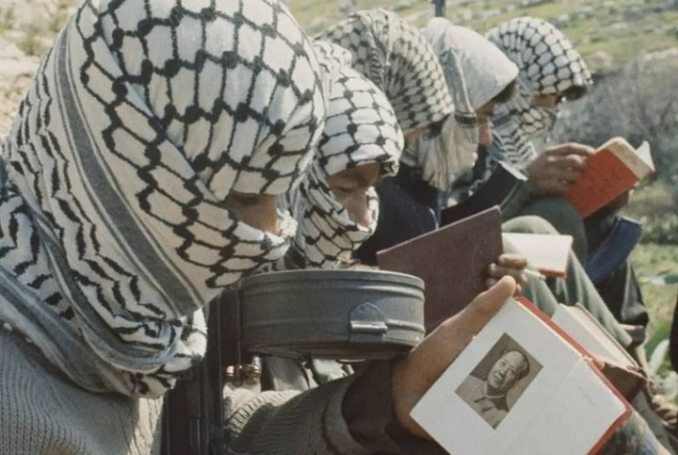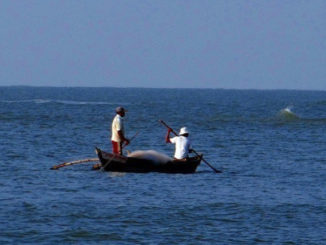
More than 80 years after the Chinese communists began building tunnels to resist the Japanese invasion of their country, this tactic of the people’s war, derived from a broader military theory, is still current and developing.
On July 16, the Lebanese resistance group Hezbollah released a video about an underground military base with impressive capabilities: in the footage, fighters circulate on foot, on motorcycles and in trucks fueled with rockets, through carefully dug tunnels.
In large chambers, combatants plan day-to-day military operations, while others drive several trucks to gates that, when opened, allow missiles to be fired directly at Israeli territory.
Elsewhere on the same base, soldiers work and are treated in a field hospital and provided with supplies that will allow them to survive for a year underground, according to the Al-Mayadeen news outlet.
Everything takes place in secret. High-tech equipment guarantees absolute encryption of the information, which is transmitted in a combination of speed and clandestinity.
The video shows the remarkable development of tunnel warfare by oppressed peoples, particularly the Arabs, some 50 years after experiences such as the Vietnam War (1955-1975) – one of those conflicts responsible for making this guerrilla tactic famous throughout the world.
Hezbollah military media published a video titled "Our Mountains, Our Treasures."
The video shows an underground missile facility named "Imad 4." pic.twitter.com/l6wtOnNq68
— The Palestine Chronicle (@PalestineChron) August 16, 2024
Guerilla Techniques
Started after the French left and the Americans arrived in the country, the Vietnam War was an emblematic case of the victory of revolutionary forces supported by the people against an army that was initially stronger and better prepared.
It was a conflict in which the weakest used guerrilla warfare techniques, including tunnel warfare, to get around the adverse conditions.
The guerrilla zones in Vietnam were taken up by networks of underground paths like the Cu Chi tunnels, which had around 250 kilometers of interconnected passages interspersed with small chambers used as classrooms and outpatient clinics and entrances and exits scattered throughout the rainforest.
In this sense, the tunnels served both for military operations and to deepen the work of the revolutionary forces with the people, since the masses also took shelter from the bombings underground and received medical treatment as well as classes alongside the soldiers.
The use of this tactic in Vietnam was also inspired by other experiences, particularly the Chinese People’s Anti-Japanese Resistance War (1937-1945).
The Red Army
During this conflict, the Red Army, led by the Communist Party of China (CPC) under the leadership of Chairman Mao Tsetung, built different networks of tunnels in a radius of approximately 250 km around Beijing to resist Japan’s imperialist offensive.
The tunnels were rudimentary, about 1 to 1.5 meters high and 70 to 80 centimeters wide, but very effective: inside were command posts, warehouses, canteens, and toilets.
The entire network was protected by armor and special doors that blocked the entry of water and toxic gasses. The access entrances were well camouflaged in all kinds of structures: bonfires, piles of hay and wells could conceal, at some point, small hatches to the underground barracks.
The movie ‘Tunnel War’ (1965) portrays the different tricks invented by the masses in the tunnels, such as a system that captured the water sent by the Japanese in flood attempts and redirected it to the villages, to reuse it for basic day-to-day operations.
Similar Tactics
Experts point out that there is a relationship of influence between the tactics used in Asia and those employed by the Arab peoples.
“Tunnels have been used for thousands of years, but the Vietnamese and Chinese have used them particularly successfully. There are several direct references to these experiences in Fatah and PFLP materials,” argues researcher Alberto García Molinero, from the University of Granada. “The general influence of the context of the time, in which there was a socialist camp, the direct connections and the acknowledgment of this inspiration all show this direct and indirect dialogue between the different scenarios.”
He explains that this inspiration took a leap forward in the 1960s when Palestinians began to apply guerrilla techniques in the armed anti-Zionist struggle after the defeats of conventional Arab armies against Israel.
The results were almost immediate: hundreds of Israeli soldiers were killed within months or weeks in actions led by the Popular Front for the Liberation of Palestine (PFLP) and Fatah.
‘People’s War’
Seeing the victory of the Chinese and Vietnamese, in this sense, was an example for Palestinian organizations, which began to study the military theories applied in those parts of Asia in order to replicate them, creatively, in their own countries.
“The success of the guerrilla struggle strategy was very much inspired by China and Vietnam. Both Asian countries were a major global inspiration for the world’s revolutionaries, much more so than the Soviet Union. This was due to various factors, including the essence of Maoism,” adds Molinero.
“Both Mao, with his concept of People’s War, and the Vietnamese demonstrated that it was possible to defeat an infinitely superior enemy, such as imperialism, as long as you mobilize the people for the cause.”
The tunnels began to be built in Gaza around the 1980s.
“Construction began after Egypt and Israel ended the Rafah partition agreement between Egyptian and Palestinian Rafah, which led to the separation of many Palestinian families. Then, as the Israeli siege against Gaza increased, the tunnels began to grow, initially more for economic reasons, for trade, than for military reasons,” explains Palestinian journalist and editor of The Palestine Chronicle, Dr. Ramzy Baroud.
Gilad Shalit
The Palestinians began using the tunnels militarily around 2006.
An emblematic operation from this period was when fighters from the Al-Qassam Brigades, the Popular Resistance Committees and the Army of Islam tunneled across the Israeli border to the town of Keret Shalom and attacked an Israeli command post.
Two Israeli soldiers were killed and one of them, Gilad Shalit, was captured. Shalit was held for five years in the Gaza Strip until he was exchanged for a thousand Palestinian prisoners in 2011.
“The capture of Shalit was one of the most successful military uses of the Palestinian tunnels at the beginning of this process. It was the moment when the seed of the use of tunnels was planted in the Palestinian landscape of resistance. After that episode, the wars of 2008 to 2009 and 2012 were new turning points in the use of tunnels for mainly military functions,” Baroud states.
Lebanese Tunnels, Yemeni Caves
Side by side with the Palestinians, other Arab nations began digging tunnels to defeat enemy forces.
The 2006 war between Hezbollah and Israel in Lebanon, which ended in victory for the Lebanese resistance, was largely determined by the tunnels, which were used to store weapons, produce and store missiles, host command bases and, of course, serve as a means of transporting troops.
Hezbollah’s construction of the tunnels began around 2000 when Israel withdrew from southern Lebanon which it occupied since 1985.
The movement’s fighters, aware of the possibility of a new occupation, began building the tunnels as a precaution, as revealed in the report Underground Environment: Tunnels to Victory, the 2006 Lebanon War.
The strategy proved to be the right one when, in fact, the Zionists invaded the country again in the new war.
Ansarallah Movement
In Yemen, the Ansarallah movement has also perfected its underground techniques.
The group has been using caves as bases since its beginnings in 1994 when it was still fighting against the reactionary government of Ali Abdullah Saleh, who was ousted in 2011. But began to develop the tactic further in 2014, the year in which Yemen was invaded by Saudi Arabia in a coordinated war with the United States to try to halt the Ansarallah advance.
Following this development, the Yemeni anti-imperialists expanded tunnel construction, using caves already mapped by former Ansarallah cells or even the former government and digging new tunnels. In recent years, satellite images have recorded new constructions of this kind in al-Hafa, al-Dabr and the capital Sana’a.
‘Gaza Metro’
Today, there is no denying that tunnels play a fundamental role in the anti-imperialist war waged by the various Arab organizations.
The scale that these structures have reached is impressive: in 2016, the former head of Hamas’ Political Bureau, Ismail Haniyeh (assassinated by Israel in July 2024), said that the tunnel network in Gaza is twice the size of the Cu Chi tunnels.
Estimates from January of this year calculate that the network could be between 563 and 724 meters long (about twice the length of the Gaza Strip) and 50 to 70 meters deep.
While some parts of the Palestinian tunnels may resemble the Chinese and Viet Cong versions in their narrowness, other parts of the “Gaza Metro” are pockmarked with cement and, in certain parts, wide enough for combatants to move through fully standing or even in vans.
“There are different types of tunnels in Gaza. The most common ones are used for defense, attacks and storage. But there are some that are used as command centers, and which oscillate between defensive and offensive nature,” explains Baroud.
Depth of Tunnels
The depth of the tunnels excavated guarantees strong security for the resistance forces.
Analysts such as Professor Zoran Kusovac argue that weapons such as ordinary iron bombs, rocket-accelerated bombs, tandem warheads and special bunker-buster bombs are all ineffective in destroying Hamas tunnels.
Iron bombs penetrate to a maximum depth of 3m, barely scratching the surface of Hamas tunnels.
Rocket-accelerated bombs work well in open terrain, and not in areas covered with buildings, constructions and rubble like the Gaza Strip, an obstacle that also prevents the use of tandem warheads.
The bunker buster, on the other hand (used to assassinate bunker busters in the war of aggression against Iraq) could work better, but Israel does not have the necessary level of knowledge about the location of Hamas tunnels to use it.
These structures, known for decades, have proven to be fundamental in the guerrilla war waged by the Palestinian National Resistance since October 7. Even before Israel’s ground invasion of Gaza, the tunnels served as a deterrent for Israel, since the Zionist military leadership knew it would have a hard time on enemy soil.
Anti-Imperialist Struggle
Ansarallah has also flaunted its hidden bases in recent years.
Following the release of satellite photos of the tunnels, Ansarallah’s Deputy Secretary of Information said that “what was presented is insignificant compared to the infrastructure we have, because they are only small tunnels for individuals”.
Hezbollah, for its part, uses the videos of its tunnels as a deterrent in the war, revealing in itself the capacity of the structures.
More than 80 years after the Chinese communists began building tunnels to resist the Japanese invasion of their country, this tactic of the people’s war, derived from a broader military theory, is still current and developing, as a result of new applications of this tactic in different concrete situations.
The anti-imperialist struggle in the Middle East has shown, more than any other revolutionary experience in the 21st century to date, the incredible relevance of the armed struggle and military doctrine developed in China and applied, even partially, by the Arab peoples.

– Enrico Di Gregorio is a Brazilian journalist. He currently writes for A Nova Democracia and contributed this article to The Palestine Chronicle.








Very informative article, but no mention of Korea! North Koreans are the greatest tunnellers and provided the Viet Cong with expertise during the american war in Vietnam.